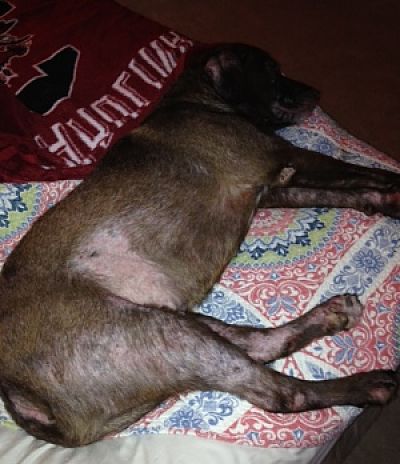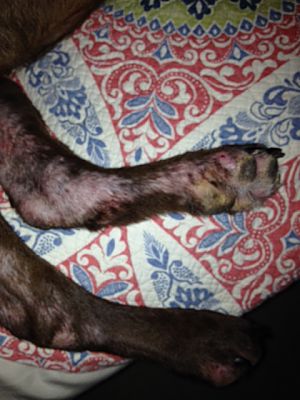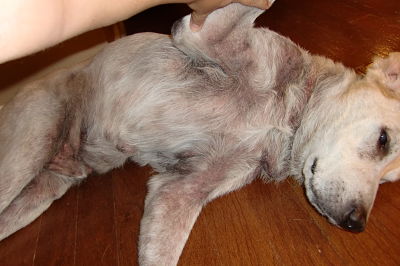Revitalize Your Dog's Life ~ Instinctively!
Canine Candida Albicans?
Candida Albicans is a very common but little known cause of so many canine health concerns. In my opinion, it is the single most common root cause of health problems in both people and dogs. It is important to realize that Candida is not a disease. Rather, it is a condition of internal imbalance. Candidiasis is a common condition. It can contribute to, and complicate many other common dog health problems.

A yeast infection is a sure sign that your dog's Immune System is not working as well as it should. A candida yeast overgrowth is an indication that balance needs to be restored in the gut. If the balance of bacteria in the gut ( small intestine ) is disrupted, this fungus can multiply very rapidly and grow out of control. Once out of control, it can enter the blood stream and travel to other parts of the body. This causes chronic yeast infections that are very hard to get rid of.
Candida Albicans Symptoms
Candida Albicans is Polysymptomatic. This means that it can show itself in many different ways. A whole list of symptoms can become apparent. Some of these symptoms may even seem quite odd. The vet may not have a reasonable explanation for why your dog is sick. Check this list of canine yeast infection symptoms.- Black/brown/yellowish gooey build up of debris in the ears
- Shaking of the head
- Skin disorders
- Rashes
- Bladder and urinary tract infections
- Hot spots
- Excessive scratching
- Genital rashes and anal itching
- Excessive licking/chewing of the paws, legs, tail or other places on the body
- Allergies
- Lethargy
- Anxiety
- Hyperactivity
- Overly hungry and overweight
- Hungry and underweight
- Joint pain and stiffness ( Arthritis )
- Bowel disorders
- Thyroid imbalance
- Bloating, intestinal gas, cramps, inflammatory bowel disease
- Strong ' doggy ' odor
- Dull, dry or greasy coat
These are just some of the symptoms of yeast overgrowth that come to mind. There are many more. If your dog has one or more of these symptoms, it is almost a certainty that he has candida albicans yeast overgrowth.
What Causes Yeast Infections in Dogs?
The Candida albicans fungus occurs normally on the body’s mucus membranes. This includes the mouth, sinuses, digestive tract, vagina and skin. The condition is the same in both people and animals.
So, how does this fungal infection problem get started?
- Antibiotics are broad spectrum. This means that they destroy up to 90% of all bacteria. Antibiotics do not differentiate between good bacteria and bad bacteria. They just kill everything! Even if you or your pet has never actually taken antibiotics, we are all still at risk because of the meat we consume. Almost all chicken, 70 percent of cattle and 90 percent of pigs are raised on feed with antibiotics.
- Feeding dogs improperly for thier species. This could be low quality grocery store food, or even expensive premium dog food containing grains, starches and too many unnecessary carbohydrates.
- Drugs and prescription medications. Chemical substances such as vaccines, flea/tick/heartworm prevention pesticides, anti inflammatory medications and other immune system suppressing drugs, create an imbalance of gut flora.
- molds in food
- mold in the environment
- can be acquired at birth from an infected mother
- chlorinated tap water
- stress
- seasons ( heat )
- chemical insecticides for the prevention fleas
- chemical insecticide treatments for tick and heart worm prevention
- environmental factors such as chemical lawn sprays and fertilizers, household cleaners, detergents, fabric softeners etc.
- immune suppressing medications
Chronic Yeast Infections Out of Control

The yeast fungus can change pathologically from a single celled organism to a branching fungal form, which can multiply rapidly. It uses root like tentacles to perforate the intestinal wall, and will damage cells there. This is called Leaky Gut Syndrome.

Research has found 17 variations of yeast, including a yeast organism called Malassezia Pachydermatitis. This particular kind of fungus can elude the immune system and resist anti-fungal medications. It is found on a dog's skin and in the ears and is responsible for causing the black, thick hyper pigmented skin often seen in dogs with chronic yeast infections.

You will recognize this as the reddish or brownish staining that is commonly found on the feet, between the toes and pads of the paws, on the chest, in the folds of the mouth, stomach, vulva and vaginal area or on the penis.
So, have you had enough bad news? Well, here's is the good news.
Yeast Infection Treatment is Possible
It will take some work and commitment to rid the body of this health robbing, fungal infection, but it can be done, and the results will be worth it. Typically our veterinarians really do not know what is wrong. Often this condition is diagnosed as allergies. So antibiotics, anti fungal medications, anti-inflammatory drugs, or steroids, are prescribed to deal with the myriad of symptoms.These yeast infection treatments often do more harm than good. The underlying root cause, which is candida yeast overgrowth remains, because the drugs continue to cause an imbalance of gut flora.
You will need to restrict certain foods in your dogs diet, which are feeding the yeast. These foods are creating an environment on which, the yeast thrives.
Diet changes alone, are not enough however.
Avoiding the yeast friendly foods will help to reduce the candida yeast over growth.
However, along with dietary changes, a successful candida treatment plan must include a targeted supplement program to get control of the yeast fungus and restore balance the way nature intended. You can learn how to cure a candida albicans overgrowth infection. Your dog's health will improve, and that will make you and your dog happier. Nothing changes unless YOU change something
No comments:
Post a Comment